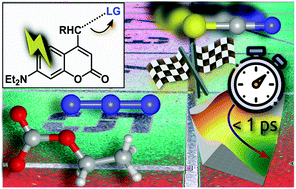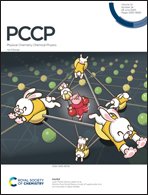Photochemical mechanism of DEACM uncaging: a combined time-resolved spectroscopic and computational study†
Abstract
The elementary steps of photocleavage in (coumarin-4-yl)methyl photoremovable protecting groups (PPGs) are elucidated by a combined electronic structure and time-resolved visible pump infrared probe (VIS-pump IR-probe) spectroscopic study. We specifically focus on the [7-(diethylamino)coumarin-4-yl]methyl (DEACM) PPG which has found increasing interest in biological applications over recent years. A series of leaving groups (LGs) are investigated, including azide (DEACM-N3), thiocyanate (DEACM-SCN), carbonate (DEACM-Carb), and a thymine nucleobase (DEACM-T) representing a model system for caged DNA. These systems are found to exhibit vastly different photocleavage time scales, ranging from the subpicosecond scale in the case of DEACM-SCN to ∼35 picoseconds in the case of DEACM-N3 and ∼540 picoseconds in the case of DEACM-Carb. In the case of DEACM-SCN, the appearance of the product is biphasic, with a fast (<ps) and a slower (20 ps) population. Conversely, the free azide and carbonate LGs appear with single exponential kinetics. Consistent with these observations, theoretical analysis based on Time-Dependent Density Functional Theory (TDDFT) studies reveals that the bright S1(π–π*) state features a barrier to dissociation that results from nonadiabatic crossings with higher-lying states. The barrier height is a sensitive function of the ligand species and of combined geometric displacements in the RC–X bond stretch coordinate (X = N, S and O, respectively) and the dihedral angle of the leaving group relative to the coumarin scaffold. Two-dimensional potential energy surface (PES) scans are carried out for these coordinates, showing that the rotation around the dihedral angle precedes dissociation of the respective leaving group. In contrast to DEACM-N3, DEACM-Carb, and DEACM-T, the DEACM-SCN system exhibits a barrierless path towards dissociation, resulting in an ultrafast photocleavage component in agreement with experiment.

- This article is part of the themed collection: 2020 PCCP HOT Articles


 Please wait while we load your content...
Please wait while we load your content...